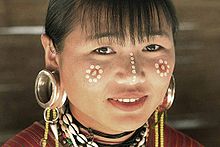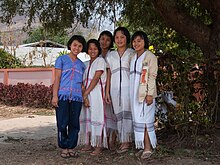Benutzer:Sarcelles/Karen-Volksreligion
The Karen[lower-alpha 1] (Vorlage:IPAc-en Vorlage:Respell), also known as the Kayin, Kariang or Kawthoolese, are an ethnolinguistic group of Sino-Tibetan language-speaking peoples. The group as a whole is heterogeneous and disparate as many Karen ethnic groups do not associate or identify with each other culturally or linguistically. These Karen groups reside primarily in Kayin State, southern and southeastern Myanmar. The Karen account for around seven percent of the Burmese population.[1] Many Karen have migrated to Thailand, having settled mostly on the Myanmar–Thailand border.




In 1938 the British colonial administration recognised Karen New Year as a public holiday.[2][3] 00-man Burmese army. However, the political arm of the KNLA – the KNU – continued efforts to resolve the conflict through political means.
The U.S. State Department has also cited the Burmese government for suppression of religious freedom.[4] There is a population of 2,500 Karen in India, mostly restricted to Mayabunder Tehsil of the Northern Andaman Islands within the union territory of the Andaman and Nicobar Islands. Nearly all of them are Baptist Protestant Christians.
Religion[Bearbeiten | Quelltext bearbeiten]

The majority of Karen are Theravada Buddhists who also practice animism, while approximately 15–30 percent are Christian.[5][6][7] Lowland Pwo-speaking Karens tend to be more orthodox Buddhists, whereas highland Sgaw-speaking Karens tend to be heterodox Buddhists who profess strong animist beliefs.
Karen animism is defined by a belief in ကလၤ k’lar (soul), thirty-seven spirits that embody every individual.[5] Misfortune and sickness are believed to be caused by k’lar that wander away, and death occurs when all thirty-seven klar leave the body.[6]
Culture[Bearbeiten | Quelltext bearbeiten]



The don dance is a traditional Karen performance. "Don" roughly translates to "in agreement". The dance is a series of uniform movements accompanied by music played from traditional Karen instruments. During the performance, a "Don Koh" leads the troupe of dancers. The don dance originated from the Pwo Karen, who developed it as a way to reinforce community values.[9]
The sae klee dance or bamboo dance is a traditional Karen performance held during celebrations such as Christmas and New Year's. Performers are typically divided into two groups. One group creates a platform by holding bamboo sticks in a checkered pattern, while the other group dances on top of the platform. Dancers must be careful to avoid stepping into one of the platform's many holes.[10]
Holidays[Bearbeiten | Quelltext bearbeiten]
The Karen New Year (ကညီနံၣ်ထီၣ်သီ) is one of the major holidays that the Karen people celebrate.[11] The date of the Karen New Year on the Gregorian calendar varies as the Karen people use the lunar calendar. The Karen New Year usually falls on a date in December or January on the Gregorian calendar.
Karen Wrist Tying (ကညီလါခူးကံၢ်စု) is an important Karen holiday. This holiday is observed annually in August.
Karen Martyrs' Day (Ma Tu Ra) commemorates the Karen soldiers who have died fighting for Karen self-determination. It is observed annually on 12 August, the anniversary of the death of Saw Ba U Gyi, the first President of the Karen National Union.[12][13] Dictionary of Reptiles. Baltimore: Johns Hopkins University Press. xiii + 296 pp. Vorlage:ISBN. ("Karen", p. 138).</ref>
Sachfremdes[Bearbeiten | Quelltext bearbeiten]
Following British victories in the three Anglo-Burmese wars, Myanmar was annexed as a province of British India in 1886. Baptist missionaries introduced Christianity to Myanmar beginning in 1830, and they were successful in converting many Karen. Christian Karens were favoured by the British colonial authorities and were given opportunities not available to the Burmese ethnic majority, including military recruitment and seats in the legislature.[14] Some Christian Karens began asserting an identity apart from their non-Christian counterparts, and many became leaders of Karen ethno-nationalist organisations, including the Karen National Union.[15]
In 1881 the Karen National Associations (KNA) was founded by western-educated Christian Karens to represent Karen interests with the British. Despite its Christian leadership, the KNA sought to unite all Karens of different regional and religious backgrounds into one organisation.[16] They argued at the 1917 Montagu–Chelmsford hearings in India that Myanmar was not "yet in a fit state for self-government". Three years later, after submitting a criticism of the 1920 Craddock Reforms, they won 5 (and later 12) seats in the Legislative Council of 130 (expanded to 132) members. The majority Buddhist Karens were not organised until 1939 with the formation of a Buddhist KNA.[2]
Buddhism[Bearbeiten | Quelltext bearbeiten]
Karen Buddhists are the most numerous of the Karens and account for around 65 percent of the total Karen population.[17] The Buddhist influence came from the Mon who were dominant in Lower Burma until the middle of the 18th century. Buddhist Karen are found mainly in Kayin State, Mon State, Yangon, Bago and Tanintharyi Region. There are Buddhist monasteries in most Karen villages, and the monastery is the centre of community life. Merit-making activities, such as alms giving, are central to Karen Buddhist life.[18]
Christianity[Bearbeiten | Quelltext bearbeiten]
Tha Byu, the first convert to Christianity in 1828, was baptised by Rev. George Boardman, an associate of Adoniram Judson, founder of the American Baptist Foreign Mission Society. Today there are Christians belonging to the Catholic Church and various Protestant denominations. Some of the largest Protestant denominations are Baptists and Seventh-day Adventists.[19][20]
A popular legend among the Karen people concerns a prophecy about a book which had been lost and would be returned by a "white brother". This is held to have been fulfilled when the first American Baptist missionaries brought the Bible to the Karen people, but this legend is probably of nineteenth-century origin.[21]
Alongside orthodox Christianity, some of those who identify themselves as Christian also have syncretised elements of animism with Christianity. The Karen of the Irrawaddy delta are mostly Christians, whereas Buddhists tend to be found mainly in Kayin state and surrounding regions. An estimated 15 to 20 percent of Karen identify themselves as Christian today[22] and about 90 percent of Karen people in the US are Christians.[23] Though other estimates put the Karen Christian population as high as 30 percent.[7]
The Karen Baptist Convention (KBC) was established in 1913. Its headquarters is in Yangon with 20 member associations throughout Myanmar. The KBC operates the KBC Charity Hospital in Insein, Yangon.
[[Category:Karen people| ]] [[Category:Ethnic groups in Myanmar]] [[Category:Ethnic groups in Thailand]]
Referenzfehler: <ref>-Tags existieren für die Gruppe lower-alpha, jedoch wurde kein dazugehöriges <references group="lower-alpha" />-Tag gefunden.
- ↑ Louise Radnofsky: Burmese rebel leader shot dead In: The Guardian, 14 February 2008. Abgerufen im 8 March 2008
- ↑ a b Martin Smith: Burma – Insurgency and the Politics of Ethnicity. Zed Books, London and New Jersey 1991, S. 50–51,62–63,72–73,78–79,82–84,114–118,86,119.
- ↑ The First Karen New Year Message, 1938. In: Karen Heritage. 1. Jahrgang, Nr. 1 (burmalibrary.org (Memento des vom 19 March 2009 im Internet Archive) [abgerufen am 11. Januar 2009]).
- ↑ Burma. In: U.S. Department of State.
- ↑ a b The Karen People. In: Karen Culture and Social Support Foundation. 20. Dezember 2015, abgerufen am 28. November 2018.
- ↑ a b Paul Keenan: Faith at a Crossroads; Religions and Beliefs of the Karen People of Burma. In: Karen Heritage. 1. Jahrgang, Nr. 1 (burmalibrary.org [PDF]).
- ↑ a b Karen. In: Minority Rights Group. 19. Juni 2015.
- ↑ The Heavens – World Treasures: Beginnings – Exhibitions – Library of Congress. loc.gov, 29. Juli 2010.
- ↑ Arts. In: www.mnkaren.org. Karen Organization of Minnesota, abgerufen am 7. Februar 2021 (englisch).
- ↑ World Refugee Day – a time to celebrate In: San Diego Union-Tribune, 22 June 2014. Abgerufen im 8 February 2021
- ↑ Kayin New Year Day 2024 and 2025 in Myanmar. In: PublicHolidays.asia.
- ↑ Rand, Nelson. "Martyr’s Day in Myanmar: Karen rebellion." Asia Times. Asia Times Online, 14 Aug. 2003. Web. 28 Apr. 2016.
- ↑ Core, Paul. "Burma/Myanmar: Challenges of a ceasefire accord in Karen state." Journal of Current Southeast Asian Affairs 28.3 (2009): 95–105.
- ↑ Josef Silverstein: Burma: Military Rule and the Politics of Stagnation. In: khamkoo. S. 16, abgerufen am 28. Juni 2017.
- ↑ Referenzfehler: Ungültiges
<ref>-Tag; kein Text angegeben für Einzelnachweis mit dem Namen keyes. - ↑ Ardeth Maung Thawnghmung, The "Other" Karen in Myanmar: Ethnic Minorities and the Struggle without Arms (UK: Lexington Books, 2012), 29.
- ↑ Yoko Hayami: Pagodas and Prophets: Contesting Sacred Space and Power among Buddhist Karen in Karen State. In: The Journal of Asian Studies. 70. Jahrgang, Nr. 4, 2011, S. 1083–1105, doi:10.1017/S0021911811001574, JSTOR:41349984 (kyoto-u.ac.jp [PDF]).
- ↑ Kirsten Ewers Andersen: Elements of Pwo Karen Buddhism. In: The Scandinavian Institute of Asian Studies. 1978, abgerufen am 14. April 2012.
- ↑ Karen Seventh-day Adventist Church Website.
- ↑ Adventist Southeast Asia Project. Archiviert vom am 7. Juli 2012.
- ↑ Alexandra Kaloyanides: Baptizing Burma: Religious Change in the Last Buddhist Kingdom. Columbia University Press, 2023, ISBN 978-0-231-55331-5, S. 24 (google.com [abgerufen am 2. Oktober 2023]).
- ↑ Referenzfehler: Ungültiges
<ref>-Tag; kein Text angegeben für Einzelnachweis mit dem Namen :0. - ↑ Karen people.